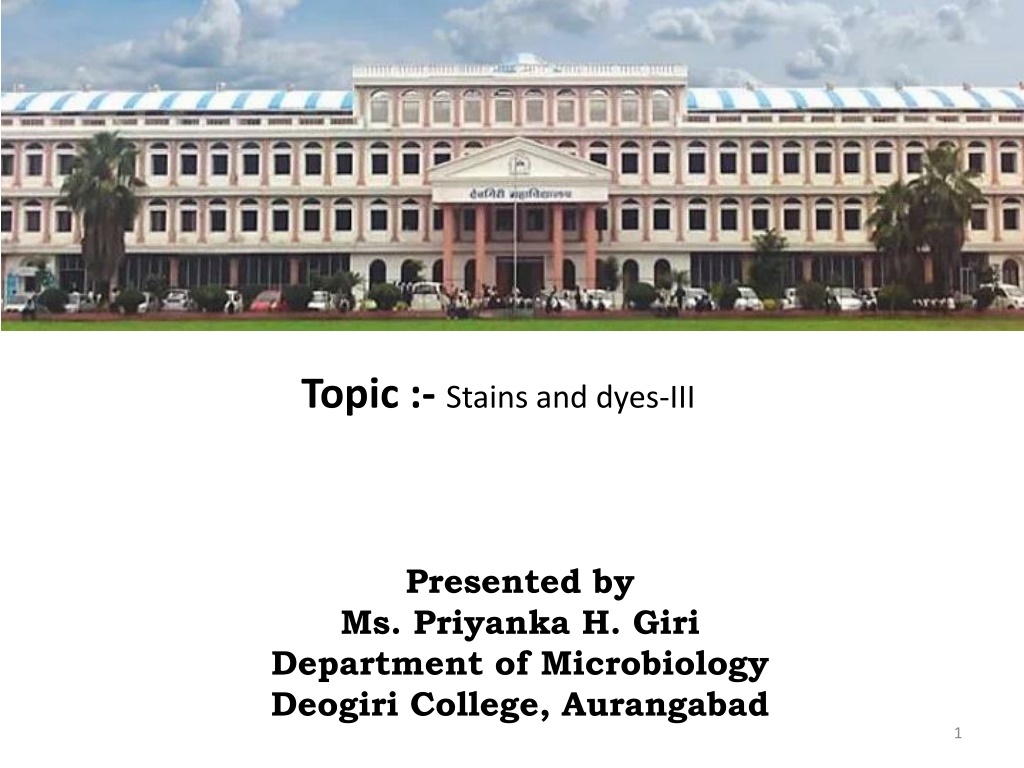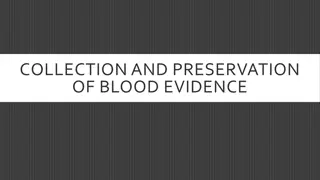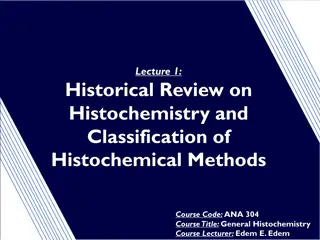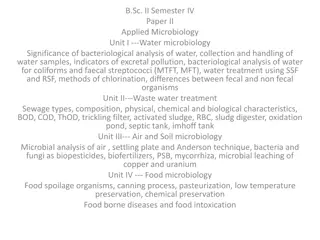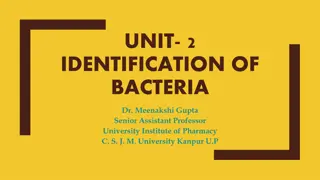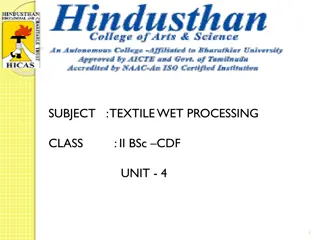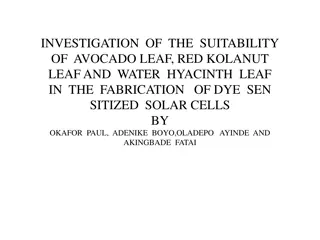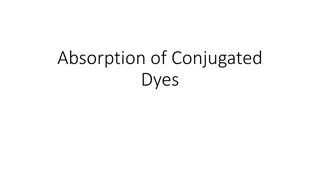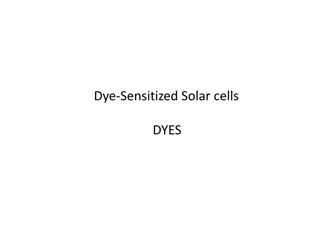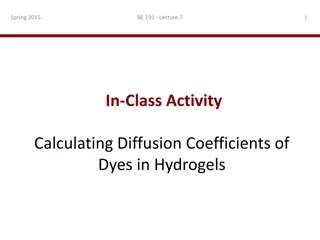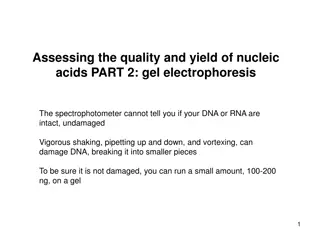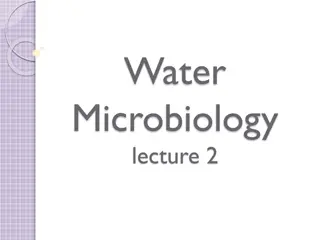Essential Microbiology Stains and Dyes Overview
This presentation delves into natural stains, leucodyes, mordants, counter stains, and their significance in microbiology. Explore the physicochemical basis of staining, fixatives, and the staining of fungi, along with examples of commonly used compounds. Gain insights into the historic use of natural stains and the role of mordants in fixing color to bacterial cells.
Download Presentation

Please find below an Image/Link to download the presentation.
The content on the website is provided AS IS for your information and personal use only. It may not be sold, licensed, or shared on other websites without obtaining consent from the author.If you encounter any issues during the download, it is possible that the publisher has removed the file from their server.
You are allowed to download the files provided on this website for personal or commercial use, subject to the condition that they are used lawfully. All files are the property of their respective owners.
The content on the website is provided AS IS for your information and personal use only. It may not be sold, licensed, or shared on other websites without obtaining consent from the author.
E N D
Presentation Transcript
Topic :- Stains and dyes-III Presented by Ms. Priyanka H. Giri Department of Microbiology Deogiri College, Aurangabad 1
B.Sc. 1st yr (1st semester) Paper no. 2 Microbiological techniques and general microbiology Ms. Priyanka H. Giri. 15/08/2020
Unit 1 Stains and Dyes.
Content: Natural stains, Leucodyes, Mordants, Counter stains, Physicochemical Basis of staining, Fixatives and fixation of Smear. Use and significance of stains in Microbiology, Staining of Fungi.
Natural stains: Natural stains are predominated during the early years of bacteriology. 1) Indigo- derived from plant indigofera and after fermentation yield stain indigo. 2) Indigo carmine 3) Orcein- Obtained from lichens. 4) Litmus- derived from livheins. 5) Hematoxyline- Prepared by extracting log wood.
Leucodyes: The chromophore group of a stain gets easily reduced by combining with hydrogen at double bonds. This reduction of chromophore results in loss of color. These decolorized stains are known as Leucodyes. For eg. Nitro group may be reduced to an amino group in parasoaniline to form leuco-parasoaniline, such satins are used as indicators of oxidation and reduction. Methylene blue reduction time (MBRT) test for indicating quality of milk is based on the same principle where reduction of methylene blue to leucomethylene blue, by bacteria takes place.
Mordants: A mordant may be defined as substance that forms an insoluble compound with stain and serves to fix the color to bacterial cell. Some stains have little or no affinity for cell or it s components. Foe eg. Cell wall, flagella, in such cases mordant is generally applied first to the smear followed by addition of staining solution or mordant is added to the staining solution and the preparation is applied to the smear in one application.
Compound which function as mordant are tannic acid and salts of aluminium, iron, zinc, copper, tin and chromium. In flagella staining, tannic acid is used as mordant. Iodine in Gram s staining is used as mordant.
Decolorizers: An agent that removes the dye from the bacterial cell is called as decolorizer. Some stained cells decolorize more easily than others depending on their chemical composition. For eg. Alcohol (Ethyl alcohol) is used in Gram s staining as decolorizer.
Counter stain: This is also a basic dye different in color than the initial (primary) one. The purpose of counter stain is to give the decolorized cell a color different from the first one. The microbes which are not decolorized by alcohol retain the first stain while the decolorized ones take up the second stain known as counter stain. For eg. In gram s staining, saffranine is used as counter stain.
Physicochemical basis of staining: Phenomenon of staining is explained by physical and chemical basis: 1. Physical basis: some dyes merely coat the surface of cell by adsorption others dissolve or precipitate in some special parts of cell due to osmosis, adsorption and capillarity. The physical process is reaction between two substances without the formation of new compound. When bacteria are stained by physical method, there is no chemical change in stain. Physically stained organisms loose stain when immersed in water, alcohol or other solvent for sufficient period of time.
2. Chemical basis: Some parts of cell are acidic in reaction while some other parts are basic. According to chemical theory of staining, acidic stain react with basic part of cell while basic stain react with acidic part of stain. The process of staining involves an exchange reaction between stain and active site of the cell. For eg. The colored ions of the dye replace other ions on cellular components. Certain chemical grouping of cell protect or nucleic acid may be involved in salt formation with positively charged ions, such as Na+ or K+, the peripheral areas of the cell, as carrying negative charge, in combination with positively charged ions can be represented as (Bacterial cell-) (Na+).
The dye methylene blue is symbolized as (MB+) (Cl-). The ion exchange during staining will take place, staining cell with methylene blue= (Bacterial cell-) (Na+) + (MB+) (Cl-) (Bacterial cell- MB+) + NaCl.
Fixatives and fixation of smear: Fixative is a compound used for fixation process. Fixation is the process in which bacterial cell is immobilized. This fixation can be done by two types of fixatives i.e., physical and chemical. The physical agents are heat and pressure while chemicals are like phenol, alcohol, acid etc. The fixation helps to fix the cells on the slide and at the same time clarifies the bacterial cell structure and their visibility and affinity of the dye towards the cell constituents.
Another important role of fixatives is in killing pathogens. A good fixation process should follow the following conditions: i. It should avoid the shrinkage of cell parts. ii. It should avoid the lysis of cell. iii. It should protect soluble cell substances. iv. The cell material should be made more rigid and resistant.
Use and significance of stains in Microbiology: Since microbial cells are generally colorless, it is extremely difficult to study them in unstained preparations as structural details are not observed clearly because of lack of density. Secondly, accurate study is difficult because of the motion of microorganisms when suspended in fluid. Also, index as they fluid in which they are suspended, which makes them nearly invisible. Fixed stained smears are most frequently used hence for the observation of morphological characteristics of microorganisms a variety of staining methods have been devised.
All these methods include certain essential steps such as the preparation of the film or smear on glass slide, fixation of the smear and application of one or more staining solutions. This makes the cell more clearly visible. Difference between cells of different species can also be demonstrated by differential or selective staining which also brings out in clear details of the various cellular characteristics or certain sub cellular structures.
Stains are also used for other purpose. Some stains which are also functioning as dyes are most widely used. These function as indicators and used for determining quality of certain substances. For eg. Methylene blue is most widely used as an indicator of oxidation-reduction potential.
Staining of Fungi: One of the simple stain commonly used for staining of fungi, algae, lower bryophytes etc is Ehrlich s Nematoxylin. Fungi may be observed more clearly by staining in lacto-phenol blue solution and mounting in lacto-phenol.
